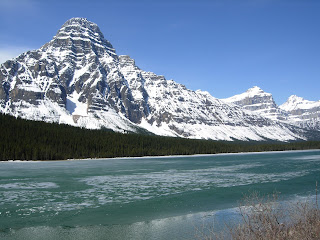The State capital of Alaska is Anchorage and with only
300,000 people, it’s not a big city. It
has a large footprint, partly because of its 5 airfields, including its
international airport as well as a huge army and airforce base. But it does house over 25% of the state’s
population. It’s quite a nice place and
we wished that we’d had more time there to explore, but on our 1 free day we’d booked a tour to a glacier camp where we
were to go dog-mushing. However, once we
got to base camp at the bottom of the glacier, we were told that the upper camp
(at 4000ft) was snowed in and in white-out conditions. We were extremely disappointed, given that
this was to be a high-light of the trip – dog sledding across a glacier, high
up in the mountains. Consequently, our chopper pilot took us up to
a lower glacier where we took a walk on the glacier, as well as flying to
another glacier to check it out as it calved into Lake George. On our walk, we marvelled at the huge crevasses
which could easily swallow us if we made a mistake and we found, embedded in
the ice, the body of a frozen mouse which may have been there for hundreds if
not thousands of years – photo attached.
The following day we were up very early to catch the Denali
Star railway train to Denali National Park.
The train is luxurious and extremely comfortable and the trip to Denali
takes some 8 hours. We arrived in Denali
(or McKinley Village) mid-afternoon to find our very comfortable lodge at
McKinley Village Lodge. Denali National
Park is 6 million acres of pristine wilderness taking in Mt McKinley, the
highest mountain in North America at 20,320ft.
To see it without cloud is unusual and it was true to form. Even with a fine (but very cold) day, we
could see only a faint outline of the mountain, behind the mountain range that
is the Alaska Mountains. However, we did
a wilderness tour into the national park and came across many animals in the
wild, including Dall mountain sheep, moose, caribou, porcupines, ground
squirrels and grizzly bears, as well as many varieties of native birds,
including hawks, eagles and the local ptarmigan – a ground based (but not
flightless) bird similar to a bush pigeon.
The park is sensational – a spectacular landscape – and the tours are
well organised and the guides very knowledgeable. Private entry to the park is banned.
Tomorrow we catch the train again for the second part of our
journey to Fairbanks, where we get to meet Julie’s aunt and cousins, who Julie
hasn’t seen since her teen years. Much
excitement! If only we could get a good night’s sleep –
the sun sets about 11pm at the moment and it’s daylight again at 4am. It’s a little disconcerting returning from
dinner with bright sunshine and a temperature of about 5 degrees. Too cold to sit outside with our last glass
of wine!































